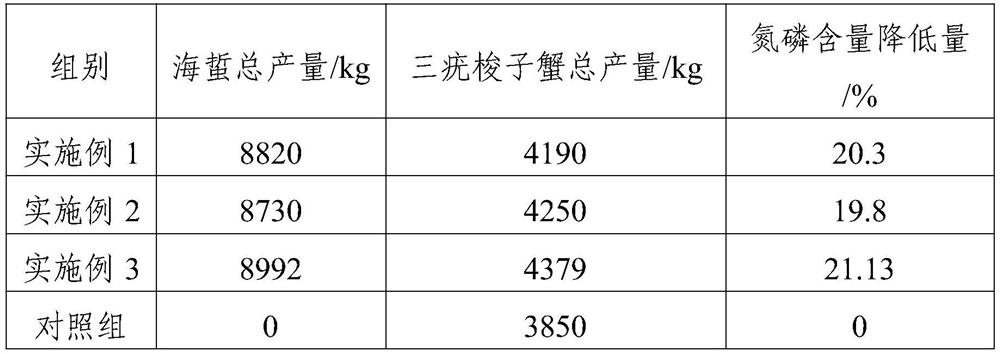In-situ water treatment method for portunus trituberculatus culture pond
A technology for Portunus trituberculatus and in-situ water treatment, which is applied in biological water/sewage treatment, water/sludge/sewage treatment, chemical instruments and methods, etc. Death, increased costs and other issues, to achieve the effect of reducing the risk of eutrophication, reducing breeding costs, and reducing costs
- Summary
- Abstract
- Description
- Claims
- Application Information
AI Technical Summary
Problems solved by technology
Method used
Image
Examples
Embodiment 1
[0023] A method for in-situ water treatment in a swimming crab culture pond, specifically comprising the following steps:
[0024] (1) Pre-breeding preparation: trim the pond to make the bottom flat, and keep the water depth of the pond at 2.5m. After the pond is filled with water, add chicken manure, duck manure, humus and amino acids to the pond, and use a polyethylene net near the central area of the pond. Enclosed as a jellyfish breeding area, the area of the polyethylene net is approximately circular, and the edge of the polyethylene net is 20cm higher than the water surface of the pond, the mesh of the polyethylene net is 20, and the area of the polyethylene net accounts for 20% of the total area of the pond ;
[0025] (2) Jellyfish breeding: The temperature of the pond water body is kept stable above 16°C, and the jellyfish seedlings are placed in the jellyfish breeding area. The time for releasing the jellyfish seedlings is from mid-to-late May to early Septemb...
Embodiment 2
[0030] A method for in-situ water treatment in a swimming crab culture pond, specifically comprising the following steps:
[0031] (1) Pre-breeding preparation: trim the pond to make the bottom flat, and keep the water depth of the pond at 2.5m. After the pond is filled with water, add chicken manure, duck manure, humus and amino acids to the pond, and use a polyethylene net near the central area of the pond. Enclosed as a jellyfish breeding area, the polyethylene net area is approximately circular, and the edge of the polyethylene net is 25cm higher than the water surface of the pond. The mesh of the polyethylene net is 40, and the polyethylene net area accounts for 25% of the total area of the pond. ;
[0032] (2) Jellyfish breeding: The temperature of the pond water body is kept stable above 16°C, and the jellyfish seedlings are placed in the jellyfish breeding area. The time for releasing the jellyfish seedlings is from mid-to-late May to early September;
[0033] (3)...
Embodiment 3
[0037] A method for in-situ water treatment in a swimming crab culture pond, specifically comprising the following steps:
[0038](1) Pre-breeding preparation: trim the pond to make the bottom flat and keep the pond water depth at 3m. After the pond is filled with water, add chicken manure, duck manure, humus and amino acids to the pond, and surround the pond with a polyethylene net near the central area As a jellyfish breeding area, the area of the polyethylene net enclosure is approximately circular, and the edge of the polyethylene net is 30cm higher than the water surface of the pond, the mesh of the polyethylene net is 50, and the area of the polyethylene net enclosure accounts for 30% of the total area of the pond;
[0039] (2) Jellyfish breeding: The temperature of the pond water body is kept stable above 16°C, and the jellyfish seedlings are placed in the jellyfish breeding area. The time for releasing the jellyfish seedlings is from mid-to-late May to early Septe...
PUM
| Property | Measurement | Unit |
|---|---|---|
| transparency | aaaaa | aaaaa |
Abstract
Description
Claims
Application Information
 Login to View More
Login to View More - R&D
- Intellectual Property
- Life Sciences
- Materials
- Tech Scout
- Unparalleled Data Quality
- Higher Quality Content
- 60% Fewer Hallucinations
Browse by: Latest US Patents, China's latest patents, Technical Efficacy Thesaurus, Application Domain, Technology Topic, Popular Technical Reports.
© 2025 PatSnap. All rights reserved.Legal|Privacy policy|Modern Slavery Act Transparency Statement|Sitemap|About US| Contact US: help@patsnap.com

